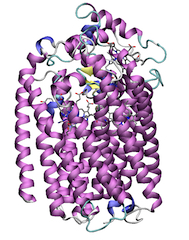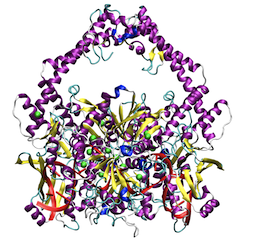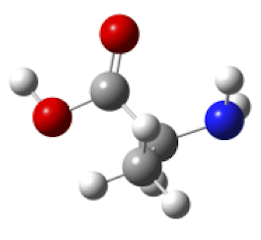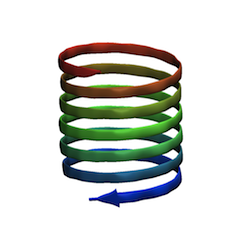Principles of life
All living organisms are composed up of simple molecules and components such as water, proteins, sugar, RNA and DNA, which make the highly sophisticated functions including self-replication and thinking. In biology, there still remain numerous questions regarding the structures and mechanisms, and many important biological phenomena are not clarified yet.
We are interested in the biological system and the large scale functions. Experimental developments are remarkably progressing, however, we are expecting that theoretical approaches can also play a important role to derive some biological findings. Fortunately, computer technologies have advanced remarkably, computer/numerical simulations will be more easily applicable.
In order to perform theoretical approaches, huge computational resources are recurred for such complicated biological systems. Thus, we are utilizing supercomputers in our center (CCS), and realistic computational simulations are performing. We will elucidate and predict the unresolved characters and chemical mechanisms of biological systems accurately. We are collaborating with experimental experts to check our results. We are also interested in the advanced fields: chemical industry, drug design and medical applications.
We are interested in the biological system and the large scale functions. Experimental developments are remarkably progressing, however, we are expecting that theoretical approaches can also play a important role to derive some biological findings. Fortunately, computer technologies have advanced remarkably, computer/numerical simulations will be more easily applicable.
In order to perform theoretical approaches, huge computational resources are recurred for such complicated biological systems. Thus, we are utilizing supercomputers in our center (CCS), and realistic computational simulations are performing. We will elucidate and predict the unresolved characters and chemical mechanisms of biological systems accurately. We are collaborating with experimental experts to check our results. We are also interested in the advanced fields: chemical industry, drug design and medical applications.
Rearch topics
QM/MM studies on the reaction mechanisms of enzymes


Important biological systems have been investigated (NOR, Topo II)
Origin of biomolecules (amino acides)

The naturally-occurring amino acids in terrestrial life are all the levorotatory (L-) form, none of the D-form. The cause for its selectivity still remains a big mystery. One of the possible scenarios is that the chiral induction of amino acids is originated from meteorites during the formation of the early solar systems. In order to validate the hypothesis, we have investigated the mechanisms of photo-induced chirality formation.
Structures of Prions

Prions are infectious proteins, where self-propagating amyloid conformations of proteins are transmitted. The Sup35 protein is the best-characterized prion in yeast,which functions as a translation termination factor. It has been shown in vitro that the N-terminal portion of Sup35 (1-123) forms the core structure of amyloid fibrils. For the amyloid fibrils of Sup35 on the basis of experimental studies, several structural models such as beta-helix, beta-solenoid and in-register model have been proposed. The beta-helix model is a nanotube in which beta-sheets are aligned along the fiber axis with a pitch of 4.7 Angstroms. However, due to the difficulty of their inherent noncrystalline and insoluble nature, the detailed structure of the amyloid fibril for Sup35 remains unclear at the atomic level. we have investigated on the validity of several amyloid models for yeast prion Sup35 by using molecular modeling and molecular dynamics (MD) simulations in combination with experimental approaches.


Important biological systems have been investigated (NOR, Topo II)
Origin of biomolecules (amino acides)

The naturally-occurring amino acids in terrestrial life are all the levorotatory (L-) form, none of the D-form. The cause for its selectivity still remains a big mystery. One of the possible scenarios is that the chiral induction of amino acids is originated from meteorites during the formation of the early solar systems. In order to validate the hypothesis, we have investigated the mechanisms of photo-induced chirality formation.
Structures of Prions

Prions are infectious proteins, where self-propagating amyloid conformations of proteins are transmitted. The Sup35 protein is the best-characterized prion in yeast,which functions as a translation termination factor. It has been shown in vitro that the N-terminal portion of Sup35 (1-123) forms the core structure of amyloid fibrils. For the amyloid fibrils of Sup35 on the basis of experimental studies, several structural models such as beta-helix, beta-solenoid and in-register model have been proposed. The beta-helix model is a nanotube in which beta-sheets are aligned along the fiber axis with a pitch of 4.7 Angstroms. However, due to the difficulty of their inherent noncrystalline and insoluble nature, the detailed structure of the amyloid fibril for Sup35 remains unclear at the atomic level. we have investigated on the validity of several amyloid models for yeast prion Sup35 by using molecular modeling and molecular dynamics (MD) simulations in combination with experimental approaches.